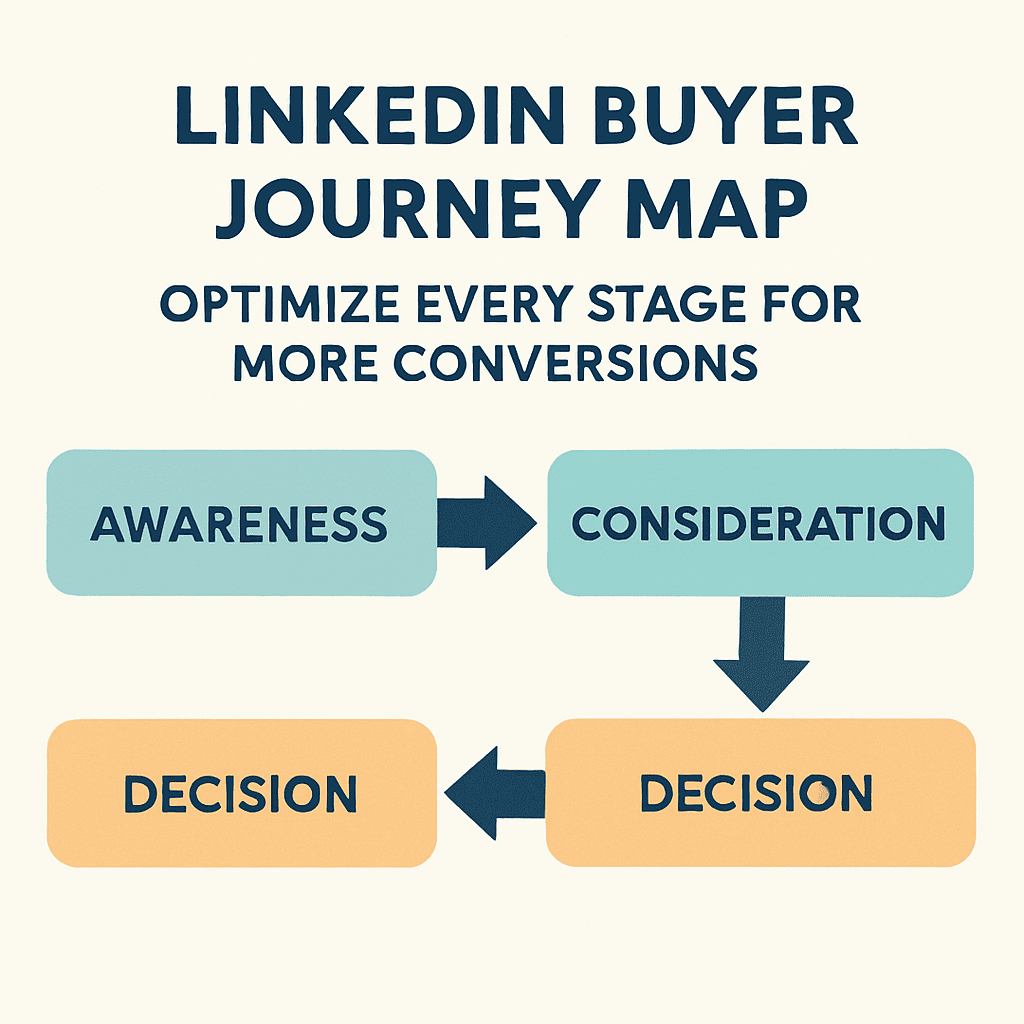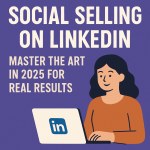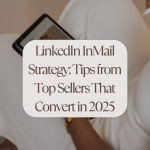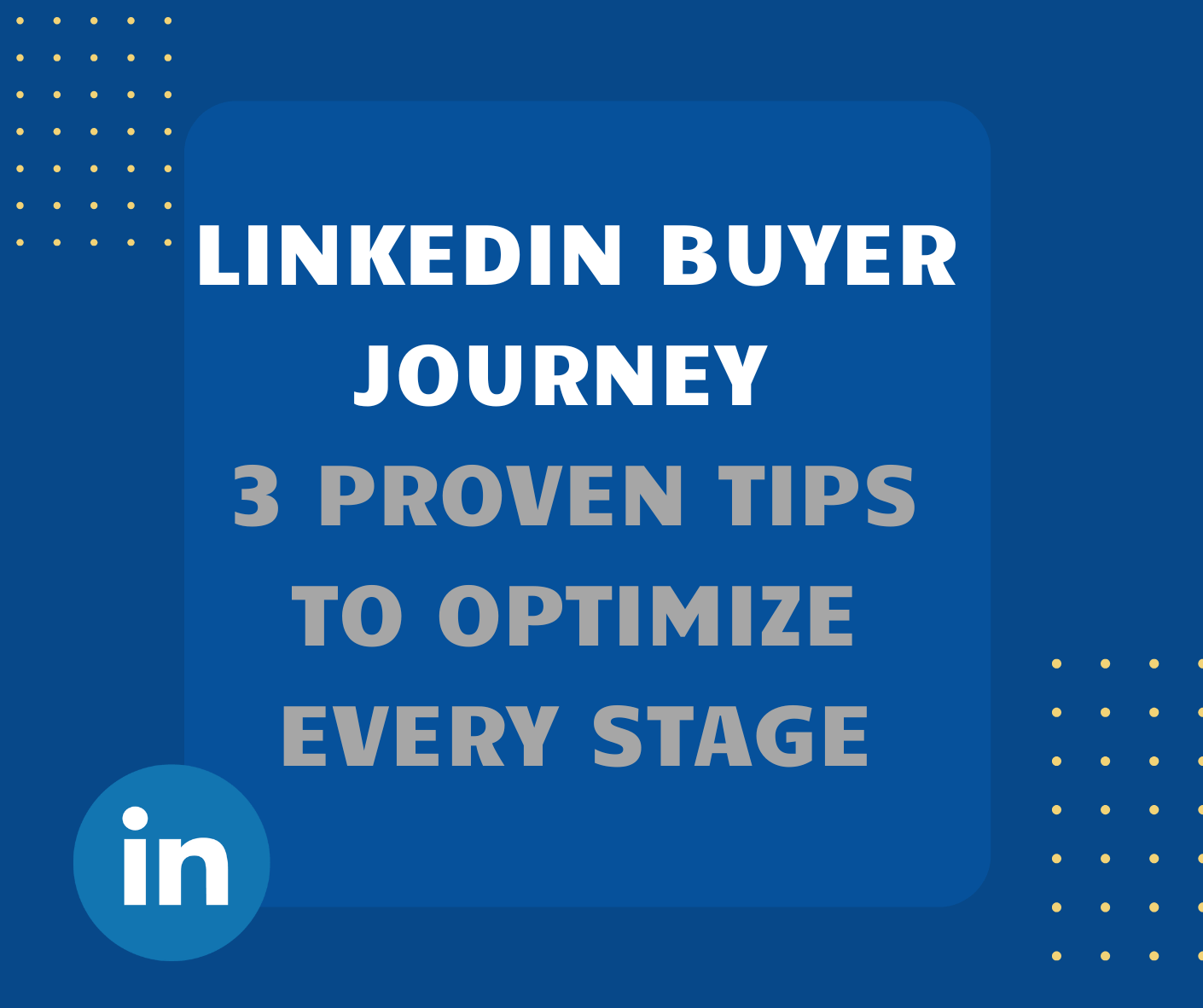
LinkedIn Buyer Journey: 3 Stages of Mapping & Optimizing for More Conversions
The LinkedIn buyer journey is similar to those on other platforms, but with a unique twist. It’s not just about making sales—it’s about building professional relationships and trust. This journey can be broken down into three core stages: Awareness, Consideration, and Decision.
Understanding the LinkedIn Buyer Journey Landscape
Unlike other social platforms, LinkedIn is inherently professional. Users come to the platform with the intent to grow their careers, make strategic business connections, and stay informed about their industry. This mindset makes LinkedIn uniquely effective for B2B marketing and relationship-based outreach. Rather than browsing for entertainment or social updates, LinkedIn users are often in a discovery or research phase, making it an ideal entry point for initiating the LinkedIn buyer journey.
Why LinkedIn Is Different
The biggest differentiator for LinkedIn is its emphasis on professionalism and industry-focused interaction. While platforms like Facebook or Instagram may prioritize lifestyle content and entertainment, LinkedIn is built around the exchange of ideas, knowledge, and business opportunities. This creates an environment where users are more receptive to educational, strategic, and solution-oriented content.
For marketers, this presents a powerful advantage. You’re engaging with an audience that’s already seeking growth, insights, and trusted partners. Delivering high-value, informative content not only captures attention but also aligns perfectly with the mindset of professionals progressing through the LinkedIn buyer journey.
Additionally, LinkedIn’s features—from detailed professional profiles to company pages, endorsements, and thought leadership posts—are structured to reinforce credibility. A well-optimized presence combined with authoritative content can drastically accelerate trust-building, which is a cornerstone of the LinkedIn buyer journey.
From Sales Pitches to Relationships
Traditional sales tactics fall flat on LinkedIn. The platform is not designed for cold selling or aggressive promotion. Instead, success on LinkedIn hinges on your ability to form meaningful, value-based relationships over time. This approach requires a shift in mindset—from pushing products to providing insights that naturally attract and engage potential buyers.
By consistently offering expertise, participating in thoughtful conversations, and addressing real-world challenges that your target audience faces, you create genuine interest. This soft-sell approach is crucial for starting and advancing the LinkedIn buyer journey.
For example, sharing a well-researched post about industry trends or hosting a discussion about solving common pain points can spark interest far more effectively than a direct sales message. When prospects perceive you as a trusted advisor rather than a seller, they’re more likely to move forward in their journey with your brand top of mind.
Moreover, this relationship-first strategy supports long-term engagement. Prospects may not be ready to buy immediately, but by staying visible and valuable, you nurture them through every stage of the LinkedIn buyer journey—from awareness to consideration, and ultimately to decision.
The Three Stages of the LinkedIn Buyer Journey
The linkedin buyer journey can be segmented into three distinct stages, each requiring its own content strategy:
- Awareness
- Consideration
- Decision
Understanding the nuances of each stage will allow you to guide your prospects from discovery to conversion more effectively.
Stage One: Awareness in the LinkedIn Buyer Journey
At the Awareness stage of the LinkedIn buyer journey, potential buyers are beginning to recognize a challenge or opportunity but aren’t yet actively searching for solutions. This is a crucial moment where your content can make a strong first impression. On LinkedIn, these individuals may come across your brand by chance—through a shared post, a group discussion, or a recommended article in their feed. Your goal here is to educate, inspire, and capture their attention in a way that positions your brand as both credible and relevant.
Capturing Attention in the Awareness Stage
Content creation at this phase should focus on sparking curiosity and delivering value without overtly promoting your services. Think of this as your chance to plant a seed.
Use storytelling techniques that reflect the common challenges your target audience faces. For example, instead of simply stating what your product does, tell a short narrative about a business that struggled with a problem and eventually found a better way forward (without selling—yet). This type of content makes the message more human and relatable, which helps draw people into the linkedin buyer journey.
In terms of formats, diversify your content to include:
- Short videos that introduce common pain points or share expert tips
- Infographics that visually explain industry trends or insights
- Slide decks or carousels that summarize challenges and high-level solutions
- Polls or questions that invite engagement and feedback
The goal is to spark interest and interaction—two essential ingredients for progressing someone into the next stage of the LinkedIn buyer journey.
The Importance of Consistent Posting
One viral post is great, but long-term recognition and trust are built through consistency. A structured content calendar not only keeps you organized but also ensures your audience repeatedly encounters your brand, reinforcing your authority in their minds.
Regular posting does more than fill space—it tells LinkedIn’s algorithm that you’re an active, engaged user, increasing your chances of being seen. More importantly, it shows your audience that you’re invested in sharing value and staying relevant—two critical trust signals at this stage of the LinkedIn buyer journey.
Aim to post at least 3–5 times per week, balancing thought leadership, engagement content, and soft storytelling. Track performance metrics to identify what resonates and adjust your calendar accordingly.
Leverage LinkedIn Groups for Authority
LinkedIn Groups remain an underutilized asset in the linkedin buyer journey. These communities provide a space where professionals actively discuss their challenges, seek advice, and explore ideas.
By joining groups relevant to your industry or audience, you can:
- Listen to real-time conversations to understand your audience’s needs
- Contribute by commenting on posts, offering insights, or sharing relevant resources
- Start discussions that invite input and establish your role as a facilitator and expert
Avoid spamming or dropping links to your website—this can quickly damage your credibility. Instead, focus on being genuinely helpful. Over time, group members will begin to recognize your expertise and will be more receptive to engaging with your content or connecting directly—advancing them along the linkedin buyer journey.
Optimize Your LinkedIn Profile
Your profile often serves as your digital handshake. When someone encounters your content or sees you in a group, one of the first things they’ll do is check your profile. An incomplete or outdated profile can instantly break the momentum of the LinkedIn buyer journey.
To make a strong impression:
- Use a professional headshot and banner image that reflects your brand
- Craft a clear, benefit-driven headline that communicates what you do and who you help
- Write a summary that tells your story—not just a resume dump, but a narrative that showcases your mission, values, and expertise
- Include keywords throughout your profile to enhance discoverability (especially those your ideal clients would search for)
Also, don’t overlook your Featured Section—this is a great place to showcase popular content, lead magnets, or introductory videos. A profile that’s optimized and consistently updated becomes a key conversion tool early in the linkedin buyer journey, establishing both trust and relevance.
Stage Two: Consideration in the LinkedIn Buyer Journey
In this phase, prospects actively seek solutions and weigh their options. Your content now needs to help guide their evaluation and decision-making process.
Host Webinars and Live Sessions
Interactive formats like webinars are excellent for deep engagement. These events allow you to present your expertise, tackle common industry challenges, and showcase how your solutions fit. This builds trust and moves the prospect further along the linkedin buyer journey.
Promote Events Strategically
Use LinkedIn’s event tools and relevant group sharing to promote your webinars. Follow up with attendees by offering supplementary materials or insights to keep the conversation going throughout their linkedin buyer journey.
Case Studies and Testimonials for Social Proof
Nothing builds trust like real-world results. Case studies showing measurable outcomes and testimonials from satisfied clients offer validation. Use storytelling to humanize these experiences and make them resonate during the linkedin buyer journey.
Use LinkedIn Ads for Targeted Outreach
LinkedIn offers advanced targeting capabilities based on job titles, industries, and interests. Tailor your ad messaging to your target audience’s pain points. Use eye-catching visuals and concise, benefit-driven copy to strengthen your linkedin buyer journey efforts.
Optimize Ads Continuously
Monitor performance using LinkedIn’s analytics suite. Adjust targeting and creatives based on CTR and conversion data. Run A/B tests to identify the most effective ad elements and refine your linkedin buyer journey tactics accordingly.
Stage Three: Decision in the LinkedIn Buyer Journey
At this point, your prospect is ready to make a decision. They’ve done the research and evaluated their options. Now, they need the final incentive to convert.
Create Urgency with Exclusive Offers
Introduce time-limited discounts or special promotions exclusive to your LinkedIn followers. These offers act as the final nudge prospects need to complete the linkedin buyer journey and become customers.
Use Personalized InMail Messaging
InMail allows for tailored, direct communication. Address specific challenges and propose personalized solutions. This human touch strengthens trust and accelerates the linkedin buyer journey.
Showcase Recommendations Publicly
Recommendations from happy clients are impactful. Ask for and display these on your profile and share them in your content. Their authenticity provides powerful reassurance to buyers completing their LinkedIn buyer journey.
Measuring and Optimizing Your LinkedIn Buyer Journey
To ensure success, you must measure how effectively your LinkedIn buyer journey map performs and make iterative improvements.
Track Engagement Metrics
Monitor likes, comments, shares, and views. These metrics indicate what content resonates most. Use these insights to double down on successful formats and topics that move people forward in the LinkedIn buyer journey.
Monitor CTR and Conversions
Evaluate click-through and conversion rates to understand how well your content drives action. This is essential for optimizing the LinkedIn buyer journey funnel and ensuring your strategies yield tangible results.
Conduct A/B Testing Regularly
Test headlines, content formats, ad creatives, and CTAs. Use findings to tweak and enhance your content, ensuring your LinkedIn buyer journey strategy evolves with user behavior.
Continuously Refine Targeting
Reassess and update your audience segments using LinkedIn’s advanced tools. Fine-tuning targeting ensures that your linkedin buyer journey remains relevant and impactful.
Stay Informed and Adaptive
LinkedIn evolves constantly. Stay current on new features and algorithm changes. Attend industry webinars and participate in LinkedIn Groups to keep your linkedin buyer journey strategy fresh and effective.
Mastering the LinkedIn Buyer Journey for Long-Term Success
Optimizing the LinkedIn buyer journey requires a strategic, relationship-first approach. It’s not merely about conversion but about nurturing trust and building a professional network. With the right content, targeting, and optimization strategies, your business can stand out, build lasting relationships, and drive consistent growth.
By focusing on value, relevance, and consistency, you can position your brand as a trusted partner in your industry, ensuring that the LinkedIn buyer journey not only leads to sales but also to lasting influence and loyalty.
Enjoyed this blog post? Follow Commenter.ai and discover how LinkedIn can unlock your next big client opportunity



